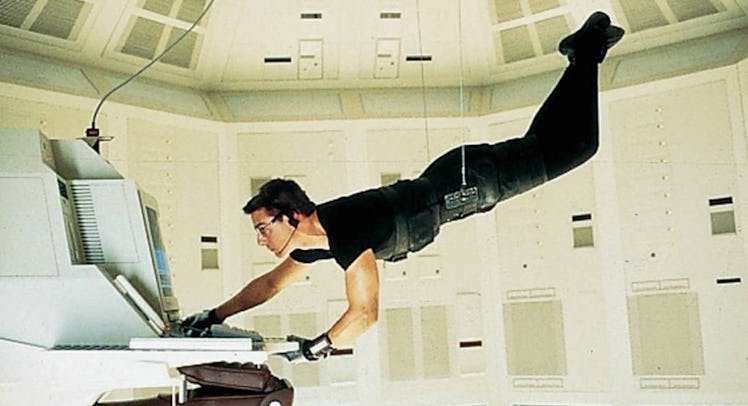How ‘Mission: Impossible’ Beat the Odds and Became a Mega-Franchise
There was a time when it seemed the action-espionage franchise was doomed. So how is it bigger than ever?

Summer movie season is officially upon us, which means action junkies can head to the theater to watch a total badass survive shootouts, explosions, and an overload of groan-worthy puns. And arguably the most anticipated action movie of the summer is Mission: Impossible – Fallout, the sixth installment in the Tom Cruise-led franchise that hits theaters on July 27. The movie is already experiencing a wave of hype and fanfare, with some suggesting the film marks a new high for the Mission: Impossible series.
Given the massive critical and financial success of the franchise this decade, it can be easy to forget that there was a time where it seemed like Mission: Impossible was doomed. While the first MI was a bonafide hit when it hit theaters in 1996, the sequel failed to live up to its predecessor. Mission: Impossible 2 may have out-earned the original, but its incoherent plot and clunky dialogue earned it mixed reviews and public interest in the franchise waned.
By the time Mission: Impossible III hit theaters a full decade after the original, it looked like the franchise had lost its luster. While the threequel received slightly more positive reviews than the sequel, it struggled at the box office, earning $134 million at the domestic box office against its $150 million budget. Typically, when a franchise sees a dip in quality and profits, the studio will pull the plug and common sense made many assume that’s what would happen with Ethan Hunt and his stale espionage antics.
But Mission: Impossible didn’t die. In fact, to the contrary, the franchise has never felt more relevant than it does in this moment. The last two movies, Ghost Protocol and Rogue Nation, both earned nearly $700 million at the global box office, along with getting positive responses from fans and critics alike. So how did Tom Cruise pull off the impossible mission of reviving a flailing franchise and transforming it into a beloved piece of the cultural landscape? It starts by examining the nature of sequels.
As Randy so eloquently explained in Scream 2, “Sequels suck!” This sentiment stems from the idea that sequels typically exist for the sole purpose of making money off an already bankable idea. So instead of coming in with fresh ideas, studios are satisfied with the screenwriters, directors, and actors hitting the same predictable notes they hit the first time around, to increasingly diminishing returns. And for the first three films, MI mostly followed this tried and true formula. Each film followed the same predictable beats in a new location with slightly bigger explosions, evil-er villains, and overall higher stakes.
Then, with Ghost Protocol, everything changed. For the first time since the original MI, the series wasn’t just going through the motions, as Director Brad Bird allowed the characters and storyline to evolve in ways that helped invigorate the super-spy and, as an extension, the entire series. In Ghost Protocol, Hunt must try to clear his name as he is also forced to try and stop a mysterious terrorist from starting a nuclear war between the United States and Russia. Rogue Nation built off this new direction perfectly, with Ethan and his crew facing off against a mysterious and sinister organization of former agents gone bad. In both movies, the stakes are both global and personal, making the franchise feel fresh again despite being 15 years old.
Along with a more thoughtful approach to the story, the franchise also benefitted by returning the focus to the action that made the series popular in the first place. This allowed the Mission: Impossible movies to set themselves apart from other action films, as Tom Cruise actually scaling the world’s tallest building in Dubai highlighted a unique intensity that makes the entire movie simultaneously feel massive and immediate for viewers, especially in contrast to most modern blockbusters.
In the age of special effects, most blockbusters are packed with CGI-heavy action sequences that are impressive but clearly not based in any form of reality. This juxtaposition ultimately works in MI’s favor, as the franchise’s more grounded and gritty approach to heart-pumping action exists sets itself apart from its over-the-top competition. Because even though the Marvel Cinematic Universe and the Jurassic World movies continue to make ungodly amounts of money, Mission: Impossible exists in a unique space that moviegoers are obviously pining for.
Beyond all of this, it shouldn’t come as a surprise that the extended relevance of Mission: Impossible goes hand in hand with the extended relevance of its star. Despite being 56 years old, Tom Cruise has managed to retain his magnetic charm and continues to look like he’d have no problem kicking any of our asses without a second thought. And while Cruise’s eccentric behavior is still the fodder of the occasional late-night joke, he’s not nearly the cultural punchline he once was.
Of course, if Skyscraper‘s massive box office flop taught us anything, it’s that no star, not even Mr. Franchise Viagra himself, has the power to guarantee a film’s success. So why is Mission: Impossible still popular 22 years after its debut? Because the MI movies are so much more than just Cruise. At their core, they’re remarkably entertaining action movies. The cast is stacked. The directing is reliable yet innovative. And, perhaps most importantly, the action sequences continue to get more and more badass with each new film. And as long as Cruise is game, there’s no reason to think Ethan Hunt won’t continue his unexpected but welcome reign over the world of cinematic espionage.
This article was originally published on